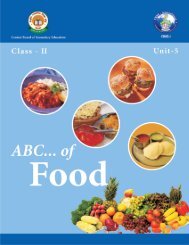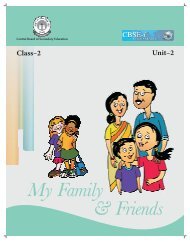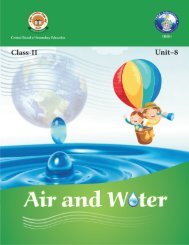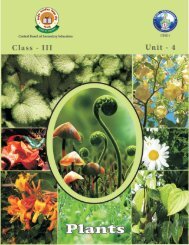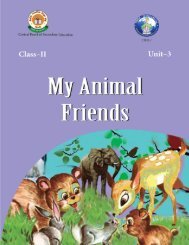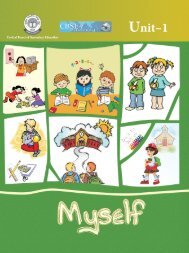English - New Indian Model School, Dubai
English - New Indian Model School, Dubai
English - New Indian Model School, Dubai
Create successful ePaper yourself
Turn your PDF publications into a flip-book with our unique Google optimized e-Paper software.
Environmental Eating Education<br />
habits<br />
Homes &<br />
food of<br />
animals<br />
Caring<br />
for<br />
animals<br />
Material<br />
required<br />
and habitat<br />
of animals<br />
Animal care<br />
What would you like for<br />
lunch? Do you think a<br />
rabbit would like to eat<br />
that? Do you think a<br />
parrot could eat your ice<br />
cream?<br />
Most animals would not<br />
like our food. They<br />
might eat it if they were<br />
hungry, but it is not<br />
always good for them.<br />
Nature needs to make<br />
sure that different<br />
animals like different<br />
kind of food, otherwise<br />
everyone would eat the<br />
same food and soon<br />
there would be none left.<br />
PPT showing different<br />
animals with unusual<br />
food kept in front of<br />
them to eat- a lion with<br />
an apple, a dog with a<br />
chocolate bar etc.<br />
followed by a question<br />
answer drill on what's<br />
wrong with the picture.<br />
Children shall discuss<br />
among themselves and<br />
write down one point<br />
each.<br />
Discussion on different<br />
animals including<br />
humans. Everyone likes<br />
to live in locations that<br />
suit their needs followed<br />
by questions which<br />
would develop critical<br />
thinking among the<br />
students - why do your<br />
parents need a home ?<br />
Ask the students about<br />
those animals, birds,<br />
insects which they<br />
generally find in their<br />
surroundings and the<br />
places they live in e.g. a<br />
spider - web, a dog -<br />
kennel etc. and<br />
familiarize them<br />
gradually with those<br />
creatures which they<br />
don't find in their<br />
immediate surroundings<br />
e.g. a lion - den, a rabbit<br />
- burrow etc.<br />
The students will be<br />
explained about:<br />
5 Things to remember to<br />
help an Animal smile-<br />
• Animals are living<br />
beings. You must take<br />
good care of them.<br />
• Spend time caring for<br />
animals.<br />
• Animals need special<br />
places to live.<br />
• Animals need right<br />
kind of food.<br />
• Animals like to keep<br />
healthy<br />
Look at the pictures of<br />
the animals and write<br />
down P for plant eating,<br />
F for flesh eating, B for<br />
both plant and animal<br />
eating and I for insect<br />
eating animals in the<br />
space given below.<br />
A grizzly bear is<br />
carrying a big bag on its<br />
shoulder surrounded by<br />
his friends. (A slide<br />
showing the same<br />
picture). Guess what his<br />
bag contains for its<br />
animal friends as their<br />
meal.<br />
A web chart showing<br />
some food items in the<br />
centre (a carrot, banana,<br />
bone and glass of milk)<br />
and pictures of animals<br />
outside (a cat, dog,<br />
rabbit and monkey). The<br />
students shall lead them<br />
to their favourite food.<br />
Using clay, sticks, rocks<br />
and other natural<br />
material, create a model<br />
of one of the animal<br />
homes you learned about<br />
recently.<br />
Read a newspaper<br />
advertisement for homes<br />
with the help of the<br />
teacher and write a<br />
similar ad that describes<br />
an animal home.<br />
Discuss with<br />
your friends<br />
about animals<br />
and their eating<br />
habits. Write<br />
down about it in<br />
your daily<br />
expression diary<br />
with the help of<br />
your parents.<br />
Take a walk in<br />
your own<br />
backyard, garden<br />
or a nearby park.<br />
Can you find any<br />
evidence of<br />
animal homes?<br />
Maintain a<br />
nature journal<br />
/daily expression<br />
diary in which<br />
you record a<br />
brief description<br />
about your<br />
findings.<br />
Feed astray<br />
animal at<br />
least once a<br />
day. Keep<br />
your<br />
environment<br />
clean. Don't<br />
throw<br />
polyethylene<br />
and other<br />
things which<br />
are harmful<br />
for the<br />
animals<br />
Encourage<br />
the students<br />
to tell their<br />
elders not to<br />
buy products<br />
which are<br />
made by<br />
killing<br />
animals e.g.<br />
leather<br />
products(Life<br />
skills/SEWA<br />
Visit a<br />
national park<br />
with your<br />
parents and<br />
see how<br />
endangered<br />
species are<br />
protected in<br />
their natural<br />
environment.<br />
Spatial<br />
intelligence<br />
Social skills<br />
Animal pictures, slides with animal pictures, bird cards, newspaper cutting, pictures of a home, farm<br />
and forest on a slide, slide for the bear activity<br />
The<br />
students<br />
identify<br />
the natural<br />
and<br />
manmade<br />
dwellings<br />
of<br />
animals.<br />
They<br />
know<br />
about the<br />
eating<br />
habits of<br />
animals.<br />
22<br />
CLASS-1



